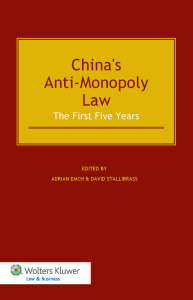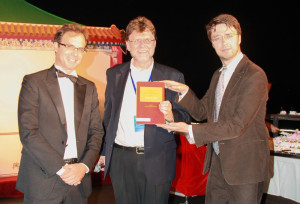A recently published book on Chinese competition law is helping foreign companies negotiate the complicated landscape of Chinese anti-trust: China’s Anti-Monopoly Law – The First Five Years provides a perfect combination of analysis and guidance.
In light of increased media interest and booming competition enforcement activity, it has become more important than ever to understand what the legal obligations are on firms operating in China, and how (and why) those obligations may be interpreted differently by Chinese enforcement agencies and courts than by their counterparts in other countries.
The book contains 27 articles by Chinese government officials and judges, Chinese and international academics, and employees of a range of private-sector law firms, consultancies and companies. It is edited by Adrian Emch, a partner at Hogan Lovells in Beijing and lecturer at Peking University, and David Stallibrass, a special consultant for Charles River Associates in Guangzhou.
In most jurisdictions anti-trust, or competition, law is a standard fixture. It affects mergers and acquisitions, joint ventures, the negotiation of the supply chain, interaction between government and the market, and the business practices of powerful (or ‘dominant’) companies. However, for most of its history, China was not known as an anti-monopoly power.
After the communist party established the ‘new China’ in 1949, both political and economic decision making became highly concentrated. Even before 1949, monopoly, not anti-monopoly, was a well-known word. For instance, salt has been a state monopoly in China for over 2,000 years.
Clearly, anti-monopoly efforts are a very new phenomenon in China. Indeed, in 1890 when the Sherman Anti-trust Act was passed in the United States, the Guangxu Emperor (and his aunt) still ruled China from the enclave of the Forbidden City, and communism was little more than a few influential books and ineffectual political parties. When the Treaty of Rome was signed in 1958, including the two articles that now make up the backbone of European Union competition law, China was about to launch The Great Leap Forward—arguably one of the largest attempts at collectivisation in modern human history.
However, in August 2008, 118 years after the Sherman Act and 50 years after the Treaty of Rome, China’s own Anti-Monopoly Law (AML) came into effect. While unlikely to have been predicted in either 1890 or 1958, it appears like a natural development in the regulation of the vigorous market economy that the Communist Party has nurtured from tentative beginnings in the late 1970s to what is now the world’s second largest economy.
Five years have passed since the AML came into force and during these years the enforcement of the AML has seen significant progress as well as considerable challenges. Most recently a series of high-profile cases and pronouncements have shot competition law in China to the top of the agenda. The National Development and Reform Commission (NDRC) reached a decision in July censuring manufacturers of baby milk powder, and more recently has confirmed that they are investigating producers of lenses and eyeglasses.
In August, the Shanghai High People’s Court ruled against Johnson & Johnson in private litigation involving retail price maintenance. The Ministry of Commerce (MOFCOM) has, sometimes controversially, intervened in mergers between foreign firms with a seemingly minimal Chinese nexus such as the purchase by Marubeni, a Japanese firm, of Gavilon, a firm whose area of operation is mostly North America.
To make sense of what is similar and what is different about competition law in China, this recent book introduces new readers to the complexities of anti-trust law in China, and also tries to provide new insight for old hands.
The 27 articles that make up the book are grouped into nine chapters and largely follow the content of the law itself. However, rather than simply provide a ‘getting the deal done’ guide to the law, a large number of the articles also provide a level of analysis and contextualising information missing from most similar volumes. This makes it ideal for foreign readers who want to understand the thinking behind the AML and how enforcement and compliance are likely to differ from competition laws in other countries.
Indeed, Bill Kovacic (former chairman of the US Federal Trade Commission and currently Global Competition Professor of Law and Policy at George Washington University) says, “Amid the excellent modern commentary on the AML, China’s Anti-Monopoly Law – The First Five Years now stands atop the ladder.”
Some of the key take-aways from the book are summarised below, chapter by chapter:
- Chapter 1 is a general introduction to the history of the AML, its high-level objectives, and the effect of the complex institutional arrangement on enforcement. One of the problems of current enforcement of the anti-trust law, which can create particular difficulties to relatively small foreign firms trying to grapple with a new system, is that there are three different enforcement authorities:MOFCOM, the NDRC and the State Administration for Industry and Commerce (SAIC). The article in Chapter 1 makes a strong case for merging the three authorities into one.
- Chapter 2 provides further background and context for readers not entirely familiar with China’s institutions, anti-trust objectives and underlying economic fundamentals. The articles in this chapter suggest that the differences in the legal and economic context mean that the AML may be enforced quite differently from anti-trust laws in other jurisdictions. In particular, there is substantial uncertainty as to how it will apply to state-owned enterprises.
- Chapter 3 looks at both agreements between market players and abuses of dominance committed by a single company. It has a particular focus on how different overlapping laws can further complicate enforcement, in particular with the Price Law often being used to target collusion on prices.
- Chapter 4 contains three articles about merger control. This is the area where the Chinese authorities have been most publicly active, making a number of important and, at times, controversial decisions.One article provides a critical commentary on the process of merger control, and another discusses both the process and substance of the MOFCOM’s unique approach to merger remedies. A final article covers the thorny issue of joint ventures. Did you know that a joint venture located in a country outside China between two firms located outside China can still be subject to Chinese merger review? If you did not, you will after having read this article.
- Chapter 5 looks at public restrictions to competition, in particular—but not only—so-called ‘administrative monopolies.’ This is a particularly notable element of the AML since competition laws in other jurisdictions are not always so explicit in their treatment of government restraints of competition.
- Chapter 6 deals with private litigation, including an article by the Deputy Chief Judge of the bench of the Supreme People’s Court that hears AML cases. The chapter provides an overview of private litigation to date, and practical guidance for the conduct and strategy of private litigation.
- Chapter 7 covers the international perspective, including the challenges faced by Chinese firms investing abroad. As much as Chinese competition law may be at times a mystery to European Chamber members, it seems foreign laws—including EU competition laws—are something new for Chinese companies.
- Chapter 8 contains an analysis of a number of issues that cut across the various sections and provisions of the AML and different enforcement methods, making connections between disparate elements of the anti-trust regime.
In particular, it covers: an assessment of whether the different economic context between China and other jurisdictions is reflected in Chinese anti-trust decisions; the relationship between the AML and China’s anti-bribery rules—a particularly hot topic after the 18th Party Congress; the treatment of vertical integration or cooperation—including foreclosure issues—across all types of conduct deemed anti-competitive under the AML; and the difficult yet very important subject of how the AML rules apply to intellectual property rights. The role of intellectual property—both its protection and assimilation—is an important element of the current debate about the future direction of China’s economy, and is key to understanding Chinese anti-trust law and policy. - Chapter 9 concludes the book providing an outlook on Chinese anti-trust in the future, as seen through the lens of one of the most interesting cases of the first five years: the enforcement case against China Telecom and China Unicom, two massive SOEs.
To comply with a young and powerful law enforced by three different agencies is hard at the best of times; when you have to bridge the sometimes substantial cultural divide between Europe and China it can be even harder. This book helps shorten that bridge and lighten that load.
China’s Anti-Monopoly Law – The First Five Years(Wolters Kluwer, 2013), is available from Wolters Kluwer (please write to sales@kluwerlaw.com) and its affiliate company CCH (please write to charles.yeung@cch.com.hk) for USD 209, or from online retailers such as Amazon.



Recent Comments